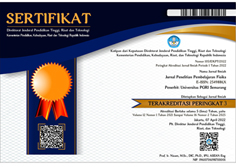**starting vol. 15 issue 4 October 2024 JP2F has moved to a new website address
https://journal2.upgris.ac.id/index.php/jp2f/index
The submission process will only be served on the web above.**
Carefully read the submission guidelines as follows:
A. General Requirements
The minimum standard requirements of the Jurnal Penelitian Pembelajaran Fisika must be:
- Written in English.
- The article must include abstract in English (100-250 words) and be following by the keywords (3-5 words).
- Use of a tool such as Zotero, Mendeley, or EndNote for reference management and formatting. JP2F uses "Journal of Physics:Conference Series" style for citation and reference.
- Make sure that your paper is prepared using the JP2F paper template.
B. Structure of The Manuscript
The manuscript must be prepared and suggested present follow the structure:
- Title. The title of the paper should describe research aims, method/model, and objective, without Acronym or abbreviation.
- Abstract. The Abstract has 100 to 250 WORDS; No citation; State in the abstract a primary objective, research design, methodology, main outcomes, and results, and the conclusions.
- Section structure. Authors are suggested to present their articles in the section structure: Introduction - Method - Result and Discussion – Conclusion - Acknowledgement - References
- Introduction. It is a mandatory to explain the objectives of the work, as well as an adequate background, a literature review, a summary of the results.
- Method. It is a mandatory to explain sufficient detail to allow the work to be reproduced.
- Result and Discussion. The results of the research are presented in the form of graphs, tables, or descriptive. Analysis and interpretation of these results are needed before they are discussed. The discussion is focused on linking the data and the results of its analysis to the problems or objectives of the study and the broader theoretical context.
- Conclusion. Conclusion summarise key results and may include any plans for relevant future work.
- Acknowledgement. The author can write thanks to those who have provided assistance or support from colleagues, superiors, or certain agencies.
- References. References list relevant papers referred to in the other sections, citing original works, both historical and recent. The referenced literature is suggested to contain more than 80% of primary reference in the last 10 years. Primary references include articles in scientific journals, proceedings, dissertations, theses, monographs, books and others which are the result of direct research.








